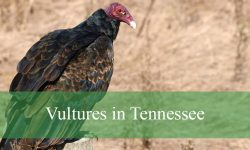Across Oregon’s diverse landscapes, wild rabbits and hares thrive, each species uniquely adapted to its environment. From the sagebrush flats of the east to the forested mountains in the northeast, these small mammals play vital roles in local ecosystems. Observing them reveals their behaviors, seasonal adaptations, and interactions with predators and humans alike.
Six species dominate Oregon’s habitats, including familiar cottontails and elusive hares. Each has distinctive physical traits, sizes, and habits, making identification easier for wildlife enthusiasts. Understanding these differences enhances any outdoor adventure and provides insight into Oregon’s rich natural diversity.
Hiking through valleys, exploring deserts, or wandering forest clearings can reveal these fascinating mammals in their natural settings. From the tiny Pygmy Rabbit to fast, agile Jackrabbits, Oregon offers numerous opportunities to encounter and appreciate these remarkable creatures.
Common Wild Rabbits Found in Oregon
Eastern Cottontail (Sylvilagus floridanus)

The Eastern Cottontail is not native to Oregon but has been introduced in certain areas of the state, particularly in the Willamette Valley. This species is medium-sized, usually measuring about 14 to 17 inches in length and weighing around 2 to 4 pounds. Its fur is brownish-gray with a white underside, and it gets its name from the fluffy white tail that resembles a cotton ball. The large, upright ears help it detect predators, making it one of the most alert rabbit species.
When it comes to behavior, Eastern Cottontails are mostly solitary and highly territorial. They are crepuscular, meaning they are most active during dawn and dusk, which helps them avoid predators like coyotes, hawks, and foxes. When threatened, they freeze in place or sprint in a zigzag pattern to confuse predators, often reaching speeds of up to 18 miles per hour. This defensive behavior is key to their survival in both rural and suburban Oregon environments.
Their diet consists mainly of grasses, clover, and various leafy plants, but they also feed on buds, bark, and twigs during the winter when vegetation is scarce. In agricultural areas of Oregon, they sometimes raid gardens and crops, which can make them a nuisance to farmers. Still, they play an important role in the ecosystem by helping control vegetation growth and serving as prey for numerous predators.
A fun fact about the Eastern Cottontail in Oregon is that it has adapted remarkably well to human-altered landscapes. You can often spot them in parks, golf courses, and backyards, where they take advantage of abundant food sources. Although not originally native, they have successfully established themselves in the state and continue to thrive alongside human populations.
Mountain Cottontail (Sylvilagus nuttallii)
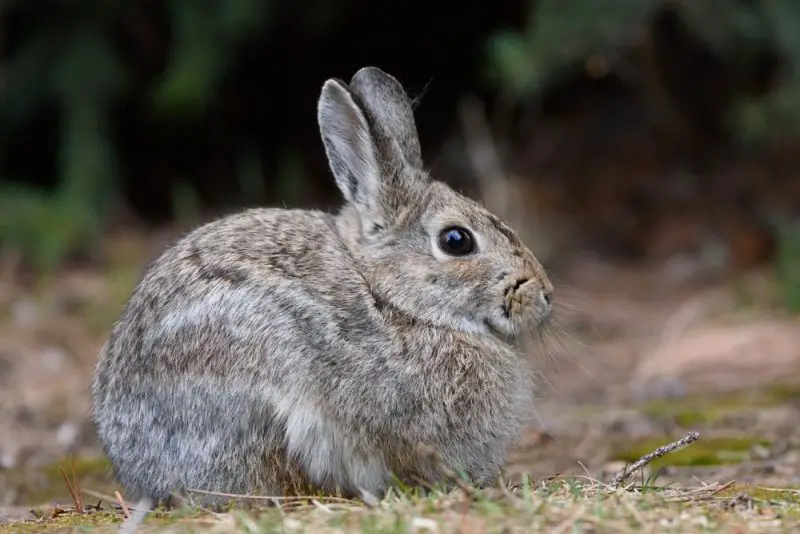
The Mountain Cottontail is Oregon’s most widespread native rabbit, often found in shrublands, open woodlands, and sagebrush country. It is smaller than the Eastern Cottontail, measuring about 12 to 15 inches long and weighing around 1.5 to 2.5 pounds. Its fur is grayish-brown with a paler belly and the signature white, cotton-like tail. The ears are relatively short compared to other cottontails, which helps in conserving heat during Oregon’s colder winters.
This species tends to be shy and secretive, relying on dense shrubs and rocky outcroppings for cover. It is mostly active during the early morning and evening hours, avoiding the hottest part of the day. Unlike the more adaptable Eastern Cottontail, the Mountain Cottontail prefers more natural, less disturbed habitats. When pursued by predators, it often uses quick bursts of speed and sudden changes in direction to escape.
The Mountain Cottontail feeds primarily on grasses, sagebrush, and other woody plants. During winter, when food is scarce, it gnaws on twigs and bark. Its digestive system is well adapted to extract nutrients from tough, fibrous plants, making it well suited for Oregon’s arid and semi-arid regions. Interestingly, like many rabbits, it practices coprophagy—re-ingesting soft fecal pellets to maximize nutrient absorption.
A fun fact is that the Mountain Cottontail can sometimes be spotted near hiking trails in eastern and central Oregon, where it occasionally ventures out in the open. Despite its timid nature, it is relatively tolerant of human presence if cover is nearby. Wildlife enthusiasts often consider it a classic symbol of Oregon’s high desert and mountain ecosystems.
Pygmy Rabbit (Brachylagus idahoensis)

The Pygmy Rabbit is one of the rarest and most unique rabbit species in Oregon. As the smallest rabbit in North America, it measures only 9 to 12 inches in length and weighs less than 1 pound. Its fur is soft and grayish-brown, blending seamlessly with the sagebrush habitat it depends on. Unlike other rabbits in Oregon, the Pygmy Rabbit has shorter ears and a very small tail, often not visible at all.
This species is highly specialized and has strict habitat requirements, living almost exclusively in dense stands of big sagebrush. In Oregon, it is mainly found in isolated areas of the southeastern part of the state. Unlike other rabbits that use burrows opportunistically, the Pygmy Rabbit digs its own, often with multiple entrances that provide escape routes from predators such as weasels and raptors.
Its diet consists almost entirely of sagebrush, especially during winter months when little else is available. During the spring and summer, it supplements its diet with grasses and forbs, but sagebrush remains its primary food source year-round. Because of this specialization, its survival is closely tied to the health of sagebrush ecosystems, making habitat loss one of its greatest threats.
A fascinating fact about the Pygmy Rabbit is that it is one of only two rabbit species in North America that digs its own burrows. This behavior provides protection not only for itself but also for young kits. Because of its tiny size and elusive habits, spotting a Pygmy Rabbit in Oregon is a rare and special experience for wildlife watchers.
Black-tailed Jackrabbit (Lepus californicus)
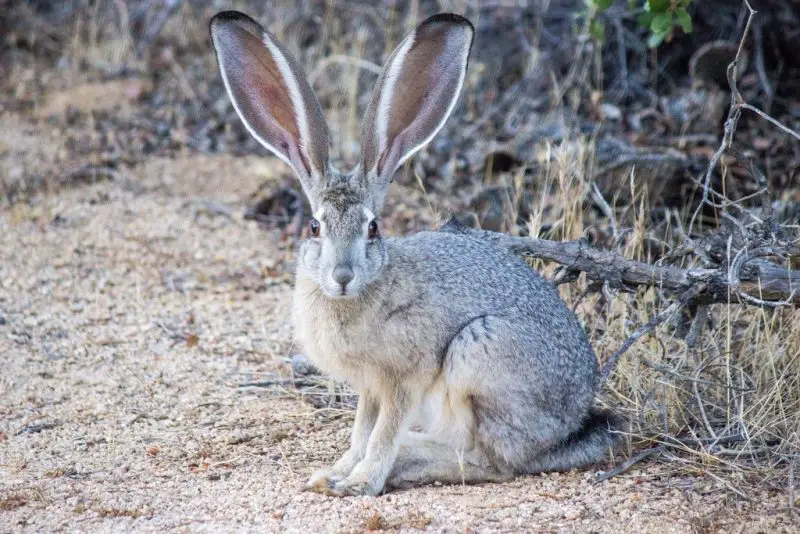
The Black-tailed Jackrabbit is one of the most recognizable rabbit species in Oregon, known for its large size and extremely long ears. It can measure 18 to 24 inches in length and weigh 3 to 6 pounds, making it significantly bigger than cottontail rabbits. Its fur is grayish-brown with a distinct black stripe running down the back and onto the long, black-tipped tail. The tall ears are not only useful for detecting predators but also serve to regulate body temperature in hot desert climates.
Unlike cottontails, the Black-tailed Jackrabbit does not rely heavily on burrows. Instead, it rests in shallow depressions called “forms” that are scraped into the ground, often beneath shrubs or grass for cover. It is primarily nocturnal, venturing out at night to feed, though it may be seen during early mornings and evenings. Its powerful hind legs allow it to leap up to 20 feet in a single bound and reach speeds of 40 miles per hour when escaping predators.
Its diet consists mainly of grasses, shrubs, and forbs, though it can survive on tough, dry vegetation during droughts. In Oregon’s arid landscapes, especially in the southeastern regions, the Black-tailed Jackrabbit plays an important role in shaping plant communities by grazing. Its ability to thrive in desert and sagebrush habitats makes it well adapted to the state’s high desert environment.
A fun fact about this jackrabbit is that it is not technically a “rabbit” but a hare, meaning its young are born fully furred and with open eyes, ready to move almost immediately. This adaptation helps them survive in open environments with little protection. Seeing one bound across Oregon’s sagebrush country at dusk is an unforgettable sight.
White-tailed Jackrabbit (Lepus townsendii)
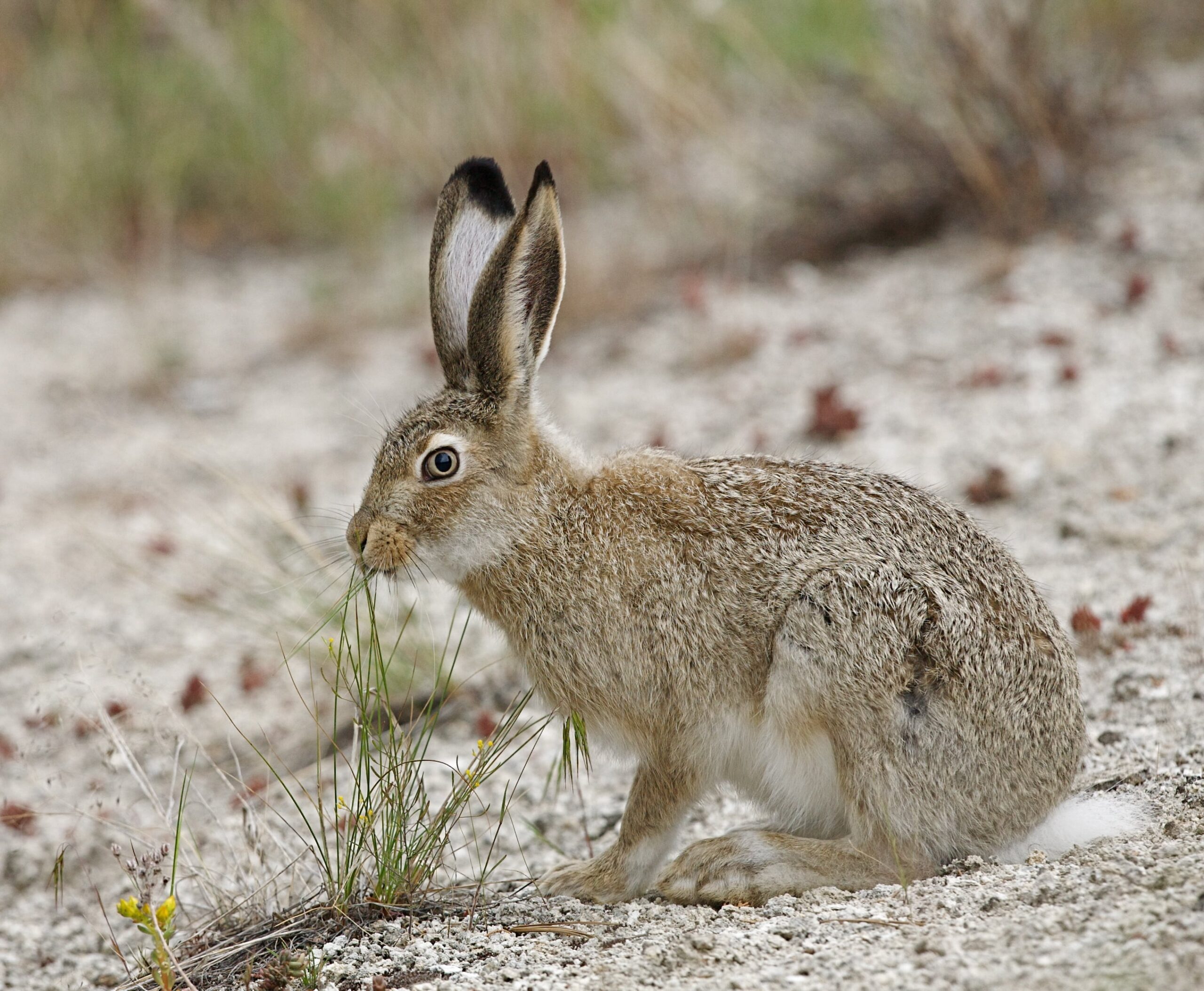
The White-tailed Jackrabbit is Oregon’s largest hare, measuring 20 to 26 inches in length and weighing 6 to 10 pounds. Its most distinctive feature is its white tail, which is especially noticeable when it runs. The fur changes seasonally—brownish-gray during summer and turning paler or even nearly white in winter, providing camouflage in snowy landscapes. Its long ears, slightly less black-tipped than the Black-tailed Jackrabbit’s, help distinguish it from its close relative.
This species prefers open grasslands, prairies, and sagebrush flats in eastern Oregon. It is primarily nocturnal, resting during the day in shallow depressions and becoming active at night to feed. Known for its agility, the White-tailed Jackrabbit can leap great distances and zigzag rapidly to avoid predators such as coyotes, bobcats, and golden eagles. Its alert nature and exceptional speed make it one of the hardest hares to approach in the wild.
Its diet is varied and shifts with the seasons. In summer, it eats grasses, clovers, and wildflowers, while in winter it survives on woody vegetation, buds, and bark. Like other hares, it practices coprophagy, re-digesting certain types of feces to extract maximum nutrients from tough plants. This behavior is especially crucial in Oregon’s harsher winter environments where food is limited.
An interesting fact about the White-tailed Jackrabbit is its seasonal coat variation, which helps it blend perfectly into both grassy summer fields and snowy winter ranges. This adaptive camouflage has earned it a reputation as one of Oregon’s most elusive hares, often spotted only when it suddenly bursts from cover and sprints across open terrain.
Snowshoe Hare (Lepus americanus)
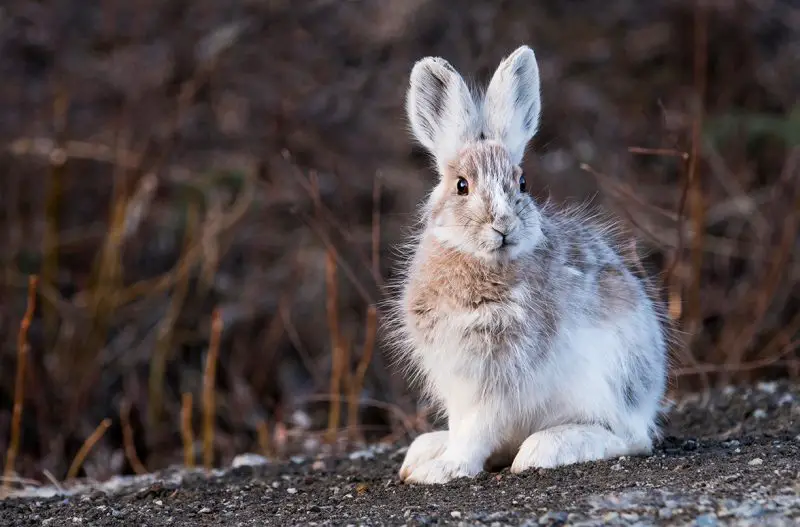
The Snowshoe Hare is famous for its large hind feet, which are covered in thick fur that allows it to move easily across snow, much like wearing snowshoes. In Oregon, this species is mostly found in the Blue Mountains, the Wallowas, and other forested regions in the northeast. It measures 16 to 20 inches in length and weighs 2 to 4 pounds. Its fur changes color with the seasons, turning brown in summer and white in winter, making it nearly invisible against snow.
Snowshoe Hares are primarily nocturnal and crepuscular, active at night and during twilight hours. They spend the day resting in dense vegetation, relying on camouflage to avoid detection. When startled, they often freeze before darting away with incredible speed and long leaps. They are a key prey species for many Oregon predators, including lynx, bobcats, hawks, and owls.
Their diet varies by season, consisting of grasses, ferns, and leaves during the warmer months, and twigs, bark, and conifer needles in the winter. They are also known to gnaw on willows and alders when snow covers ground vegetation. Like other rabbits and hares, Snowshoe Hares re-ingest soft fecal pellets to extract additional nutrients from fibrous plant material.
A fun fact about Snowshoe Hares is that their population numbers fluctuate in cycles of roughly 7 to 10 years, strongly influencing predator populations. In Oregon, spotting a Snowshoe Hare during the winter, with its pure white coat blending into snowy landscapes, is a rare and rewarding experience for wildlife observers.
Best Time and Place to See Wild Rabbits in Oregon
Wild rabbits and hares in Oregon are generally most active during the cooler hours of the day, making early morning and late evening the best times to spot them. During these periods, they emerge from cover to forage on grasses, leaves, and other vegetation. In the middle of the day, especially during the summer, they usually remain hidden in dense brush, rocky outcrops, or shallow ground depressions to avoid heat and predators. Winter sightings are also common for species like the Snowshoe Hare, which are more visible against snowy landscapes.
The best places to see rabbits vary depending on the species. Eastern Cottontails are more common in western Oregon, especially in the Willamette Valley, where they thrive in farmlands, suburban parks, and grassy edges. Mountain Cottontails are more widespread in central and eastern Oregon, favoring sagebrush flats, open woodlands, and rocky terrain. For those seeking the tiny and elusive Pygmy Rabbit, southeastern Oregon’s sagebrush country is the only place to look, though spotting them is rare due to their secretive nature and limited range.
If you want to see hares, head to Oregon’s high desert and grassland regions. The Black-tailed Jackrabbit is often spotted in sagebrush country and open rangelands of southeastern Oregon, while the White-tailed Jackrabbit prefers higher elevation prairies and shrublands in the east. For Snowshoe Hares, the forested mountains of northeastern Oregon, including the Blue Mountains and the Wallowa range, are the best habitats. Their seasonal color change makes them especially exciting to observe, particularly in snowy conditions.
Overall, the best chance to see wild rabbits in Oregon is to explore natural habitats at dawn or dusk while remaining quiet and patient. Look along field edges, sagebrush flats, and forest clearings. Many wildlife watchers enjoy rabbit-spotting trips in spring and summer, when populations are at their peak and young rabbits begin to venture out. Each species reveals a different side of Oregon’s diverse landscapes, from lush valleys to rugged deserts and mountain forests.
FAQs about Wild Rabbits in Oregon
What types of wild rabbits live in Oregon?
Oregon is home to several species of rabbits and hares, including the Eastern Cottontail, Mountain Cottontail, Pygmy Rabbit, Black-tailed Jackrabbit, White-tailed Jackrabbit, and Snowshoe Hare. Each species has its own preferred habitat, ranging from sagebrush flats to mountain forests.
When is the best time to see wild rabbits in Oregon?
The best time to see wild rabbits is during dawn and dusk, when they are most active and feeding. Some species, like the Snowshoe Hare, are also more visible in winter because of their seasonal white coats that contrast with the snow.
Where can I find rabbits and hares in Oregon?
Eastern Cottontails are most common in the Willamette Valley and western Oregon, while Mountain Cottontails are widely distributed in central and eastern parts of the state. Pygmy Rabbits are restricted to southeastern Oregon’s sagebrush country. Jackrabbits and Snowshoe Hares are found in the high deserts, grasslands, and forested mountains of the east.
What do wild rabbits in Oregon eat?
Wild rabbits primarily feed on grasses, herbs, and leaves during spring and summer. In winter, their diet shifts to bark, twigs, and woody plants. Pygmy Rabbits depend heavily on sagebrush year-round, while Snowshoe Hares supplement their diet with conifer needles when food is scarce.
Are wild rabbits active during the day?
Most wild rabbits in Oregon are crepuscular, meaning they are active at dawn and dusk. Some may also be active at night, especially in open habitats where predators are common. During the day, they usually rest in burrows, shrubs, or ground depressions to avoid detection.
Do wild rabbits in Oregon hibernate in winter?
No, wild rabbits and hares in Oregon do not hibernate. Instead, they remain active throughout the year, adjusting their diet to available food sources. Snowshoe Hares, for example, survive the cold months by eating twigs, bark, and needles, while also using their white winter coats for camouflage.
Are rabbits and hares the same in Oregon?
Although people often use the terms interchangeably, rabbits and hares are different. Cottontails and Pygmy Rabbits are true rabbits, while Jackrabbits and Snowshoe Hares are hares. Hares are generally larger, faster, and give birth to more developed young compared to rabbits.
Can you see Pygmy Rabbits easily in Oregon?
Pygmy Rabbits are extremely elusive and rare in Oregon. They live only in dense sagebrush areas of the southeast and are much harder to spot than other species. Wildlife enthusiasts consider seeing one in the wild a very special experience.

